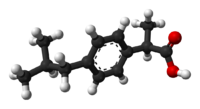
Photo from wikipedia
Pain models are mostly in rodents and between them formalin orofacial test allow discrimination among antinociception and anti-inflammation. This assay use a formalin solution injected into the upper right lip… Click to show full abstract
Pain models are mostly in rodents and between them formalin orofacial test allow discrimination among antinociception and anti-inflammation. This assay use a formalin solution injected into the upper right lip of each mouse which produces two periods of pain separated by an inactive period. The aims of the present study were to evaluate, by means of the isobolographic analysis, the antinociception and anti-inflammatory activities of the following NSAIDs: dexketoprofen, diclofenac, piroxicam and metamizole in an orofacial. The NSAIDs administered intraperitoneally produced a dose-dependent activity with the following order of potency of the rubbing behavior, in phase I: diclofenac>dexketoprofen>piroxicam>metamizole and in the phase II: metamizole>diclofenac>piroxicam>dexketoprofen. The coadministration of NSAIDs resulted in a synergistic interaction, which according to the value of the potency of the combination (II) presents the following range: dexketoprofen plus metamizole>dexketoprofen plus diclofenac>dexketoprofen plus piroxicam, in phase I and dexketoprofen plus metamizole>dexketoprofen plus piroxicam>dexketoprofen plus diclofenac, on the phase II. Data obtained in this work corroborate that NSAIDs alone or in combination inducing activities by additional mechanism of action supplementary to inhibition of COXs. This fact represent a novel approach that could be used as multimodal management of orofacial pain, since with this treatment strategies, by the reduction of doses, can help to diminish side effects of other dugs such opioids.
Journal Title: Drug research
Year Published: 2020
Link to full text (if available)
Share on Social Media: Sign Up to like & get
recommendations!